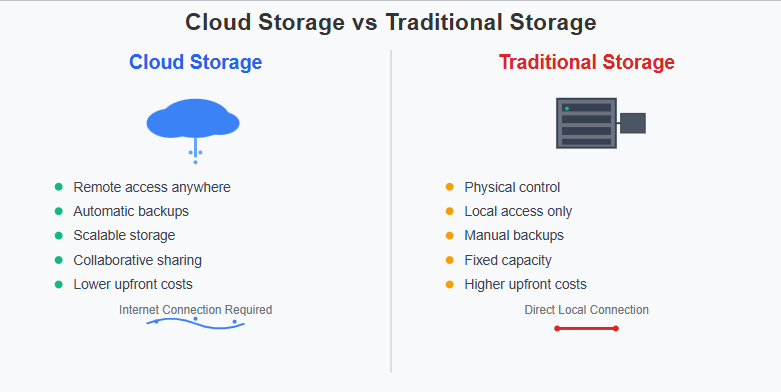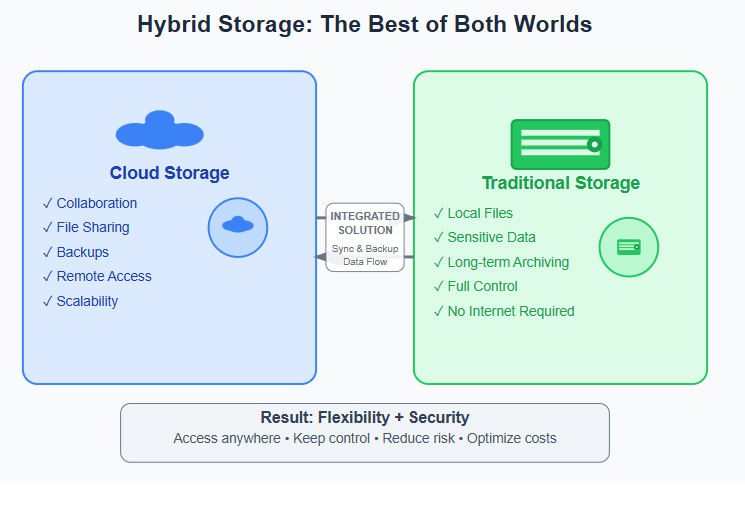In today’s fast-paced digital world, data storage is central to both personal and professional activities. Every photo you take, every document you write, and every business file you create need a secure location. The main query is whether you should continue using more conventional methods of data storage, such as external storage devices, servers, or hard drives, or switch to cloud storage.
Both options will be explained in simple, straightforward terms in this guide. To help you decide which storage option is best for you, we’ll examine their benefits and drawbacks, costs, security, and usability.
1. Understanding Cloud Storage
When you use third-party services like Google Drive, Dropbox, Microsoft OneDrive, Amazon S3, or ServerAvatar cloud hosting to store data online, that’s called cloud storage. You upload files to remote servers that you can access from anywhere with an internet connection instead of only keeping them on a physical device.
It’s similar to renting a storage locker that you can access whenever you want and from any location without physically being there.
2. Understanding Traditional Storage
When people talk about traditional storage, they usually mean keeping data on physical devices like hard disks (HDDs).
- Hard drives (HDDs)
- Solid-state drives (SSDs)
- USB flash drives
- CDs/DVDs
- On-premise servers
You can access your files in this manner without using the internet. It’s similar to keeping your possessions safe at home. You have the key, but there isn’t enough space or access to them.
3. Key Differences Between Cloud and Traditional Storage

| Feature | Cloud Storage | Traditional Storage |
|---|---|---|
| Accessibility | Accessible from anywhere with internet | Accessible only where the device is |
| Cost | Subscription-based (monthly/yearly) | One-time purchase, occasional upgrades |
| Scalability | Easily scalable (pay for what you use) | Limited by hardware capacity |
| Security | Provider-managed with encryption & backups | User-managed, depends on device safety |
| Data Sharing | Easy with links & collaboration tools | Manual transfer via USB, email, etc. |
| Maintenance | Handled by provider | User must maintain hardware |
4. Advantages of Cloud Storage
Several factors have contributed to the rise in popularity of cloud storage:
- Accessibility Anywhere, Anytime: All you need is a connection to the internet.
- Real-time collaboration is made simple by allowing multiple users to work on the same file.
- With automatic backups, you don’t have to worry about doing file copies by hand.
- Scalable Storage: As your needs increase, start small and grow.
- Disaster Recovery: In the event that your device is lost or damaged, your data is safe.
5. Disadvantages of Cloud Storage
Despite its benefits, cloud storage has a few limitations:
- Dependency on the Internet: Without a strong connection, it’s difficult to continue.
- Expenses incurred repeatedly: Monthly or annual subscriptions may accumulate.
- Privacy concerns: Sensitive information is impacted by the supplier’s security policies.
- Issues with Data Migration: Changing providers could be challenging.
6. Advantages of Traditional Storage
Conventional storage is still helpful, particularly in the following circumstances:
- Limited Capacity: Hardware eventually runs out of room.
- Physical damage risks include the possibility of devices breaking, crashing, or disappearing.
- There is no automatic backup; you must ensure that you have a backup on your own.
- Because you have to move or copy data, sharing is less convenient.
7. Disadvantages of Traditional Storage
- Limited Capacity: Hardware eventually runs out of room.
- Physical damage risks include the possibility of devices breaking, crashing, or disappearing.
- There is no automatic backup; you must ensure that you have a backup on your own.
- Because you have to move or copy data, sharing is less convenient.
8. Cost Comparison
- Costs for cloud storage are typically determined by membership tiers. For example, enterprise options like Amazon S3 or ServerAvatar cloud hosting charge per GB saved and moved, while Google Drive charges roughly $2 per month for 100GB of space.
- Traditional Storage Costs: The initial cost of a 1TB external hard drive can range from $50 to $70. However, if you require a large amount of server storage, the setup, electricity, and maintenance costs increase significantly.
For large-scale, long-term storage, traditional methods might be more affordable. Generally speaking, cloud storage is less expensive for collaboration and flexibility.
9. Security Considerations
- To protect your data, the majority of cloud storage services employ encryption, two-factor authentication, and frequent backups. However, there are issues like data leaks, hacking, and difficulties adhering to regulations when sensitive data is involved.
- Conventional Storage Security: Security is your responsibility. Even if you avoid online dangers, theft, fire, or inadvertent deletion can still result in data loss.
Using both can help balance these risks
10. Which Storage is Better for Businesses?
- Cloud storage is the best option for small businesses because it is easy to use, has lower upfront costs, and can expand with the company.
- Large corporations ought to combine the two. On-premise servers handle large or sensitive data, while cloud storage handles backups and remote work.
- Because cloud storage is affordable, flexible, and facilitates file sharing, it is a popular choice for creators and freelancers.
11. Hybrid Storage: The Best of Both Worlds
Today, many individuals and businesses use a variety of storage types. For example, you can collaborate, share files, and backup your data using cloud storage.
For locally stored files, sensitive information, and long-term preservation, use traditional storage.
This combination ensures both flexibility and security.

12. Future of Storage: What’s Next?
With the growth of remote work, big data, and artificial intelligence, cloud-first strategies are becoming more and more popular. Traditional storage will still be useful for offline access, compliance requirements, and data-heavy industries, so it won’t be going away anytime soon.
FAQ
1: What is the difference between cloud and traditional storage?
Cloud stores data online, while traditional stores it on physical devices.
2: Is cloud storage safe?
Yes, but it depends on the provider. Traditional storage avoids online risks but can be damaged or stolen.
3: Which is cheaper?
Cloud has ongoing fees, traditional needs one-time investment.
4: Can I use both together?
Yes, a hybrid model combines flexibility and security.
5: Which is better for business?
Cloud works best for small teams, hybrid suits larger enterpris
Conclusion
The truth is that neither is always superior; it depends on what you require. Cloud storage is better for flexibility, accessibility, and working together, while traditional storage is better for control, one-time costs, and being reliable while you’re not online.
Most consumers and enterprises should choose a hybrid strategy, which combines the ease of use of cloud storage with the dependability of traditional storage.
In the end, the “better” solution is the one that works best for you in terms of security, cost, and ease of use.
Stop Wasting Time on Servers. Start Building Instead.
You didn’t start your project to babysit servers. Let ServerAvatar handle deployment, monitoring, and backups — so you can focus on growth.
Deploy WordPress, Laravel, N8N, and more in minutes. No DevOps required. No command line. No stress.
Trusted by 10,000+ developers and growing.
